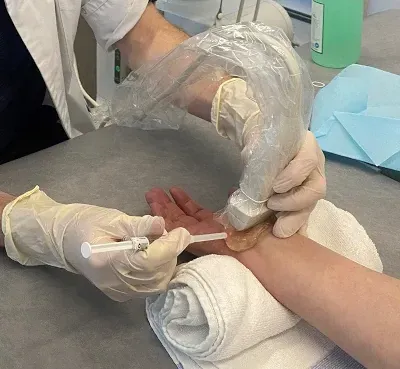Hydrodissection for Carpal Tunnel Syndrome
Hydrodissection for carpal tunnel syndrome is performed by a doctor. It involves injecting fluid around the median nerve, under ultrasound guidance, to separate it from surrounding adhesions inside the carpal tunnel. The aim of this technique is to improve nerve gliding and reduce symptoms like pain, numbness, and tingling.
Table of Contents
- What is it?
- What to expect
- How it works
- When it's used
- How effective is it?
- Benefits
- Summary
What is it?
Nerve hydrodissection is a medical procedure that frees up adhesions (scar tissue) around a nerve. With carpal tunnel syndrome, the adhesions occur around the
median nerve deep inside your wrist joint.
First the doctor identifies the median nerve using
ultrasound. Then, the same ultrasound is used to guide a hypodermic needle very close to your median nerve. Medication is injected around the nerve, which pushes away adjacent tissues. This frees up the nerve from the tissue which were compressing or entrapping it.
What to expect
Ultrasound-guided hydrodissection for carpal tunnel syndrome is not a painful procedure. The only minor pain in the procedure involves the needle prick at your wrist. From start to finish, the entire process takes 10 to 45 minutes.
The procedure begins with the doctor identifying your median nerve using ultrasound. Then the doctor follows the nerve, looking for areas of scarring, swelling, and thickening.
Once the affected area is identified, your skin is sterilized. The doctor inserts and advances the hypodermic needle under constant ultrasound guidance to the affected nerve. The doctor stops advancing the needle immediately adjacent to the nerve. Then medicine in injected around the nerve. The force of the injected fluid frees the nerve from surrounding scar tissue and adhesions that compress it.
While the needle is still near the nerve, the doctor will inject above and below it. This ensures the injection completely frees the nerve from all of the surrounding tissues.
How it works
The reason you have carpal tunnel syndrome is because tendons in your wrist joint have become
swollen with inflammation. In time, the swelling produces adhesions between the tendons and the nerve. That means the nerve is “entrapped” or “stuck” to the adjacent adhesions.
More swelling produces more adhesions. So as the tissues push against the median nerve, it becomes damaged by compression. This compression is what causes all of the
symptoms of carpal tunnel syndrome, including
pain,
numbness,
tingling,
shooting electric shocks,
burning,
weakness, and
clumsiness.
Hydrodissection requires fluid to be injected adjacent to the median nerve. The fluid gently pushes away the structures which compress the nerve, allowing it to move more freely. As a result, symptoms disappear in most patients.
When it's used
Hydrodissection is most often considered as an alternative to surgery. It’s usually used as a treatment option after conservative measures like
night bracing,
myofascial massage, and
stretching exercises have failed. It is also used when traditional
cortisone injections fail. Such failure of conservative therapies is common in
severe cases of carpal tunnel syndrome, especially if there is severe pain, numbness or weakness.
How effective is it?
Studies show that hydrodissection can be effective in treating carpal tunnel syndrome in most patients. But its degree and effectiveness depends on
several factors. First and foremost is the individual patient's response to other (prior) carpal tunnel treatments. Also affecting hydrodissection outcomes is how long the patient has had symptoms, how severe they are, and the volume of hydrodissection solution (medicine) used.
The volume of the injected medicine can impact the clinical outcome. For example, injections that use a higher volume of fluid have better results. But not all patients can tolerate a higher injected volume.
In most cases, ultrasound-guided hydrodissection for carpal tunnel syndrome can provide significant symptom improvement. This includes reduction of numbness and pain, and improved hand function like strength.
Relief can last from a few weeks to several months. Some studies show even longer relief, lasting up to 6 months. Longer relief can be obtained with multiple injections over a period of 1-3 years.
Benefits
Hydrodissection for carpal tunnel syndrome is used when other conservative treatments have failed. For most patients, it provides significant relief from pain or numbness, improved function, and reduces the need for surgery.
Numerous clinical trials have demonstrated positive results from hydrodissection for carpal tunnel syndrome. Specifically, improvements in pain and function are primary results. In some patients, the outcomes are only as good as injecting corticosteroid into the wrist.
Safety
Numerous studies over the past decade have shown that hydrodissection is a
safe and effective treatment for carpal tunnel syndrome.
Since the advent of more sophisticated ultrasound imaging, your doctor does not need to “guess” where the median nerve is. Rather, they can directly visualize the nerve to ensure accurate needle placement. This is a true revolution because improper placement of the needle and injection can damage the nerve. This was a more common complication in past years.
Summary
Hydrodissection for carpal tunnel syndrome is a minimally invasive treatment that doctors use when traditional, conservative therapies have failed. Using an ultrasonically guided hypodermic needle, the doctor locates the median nerve and then injects fluid around it. This frees the nerve from any surrounding adhesions. Hydrodissection reduces the need for surgery and has generally good outcomes.
About





